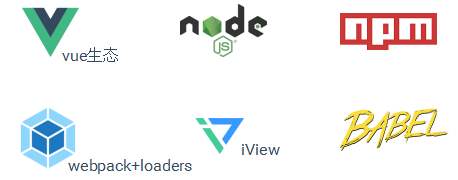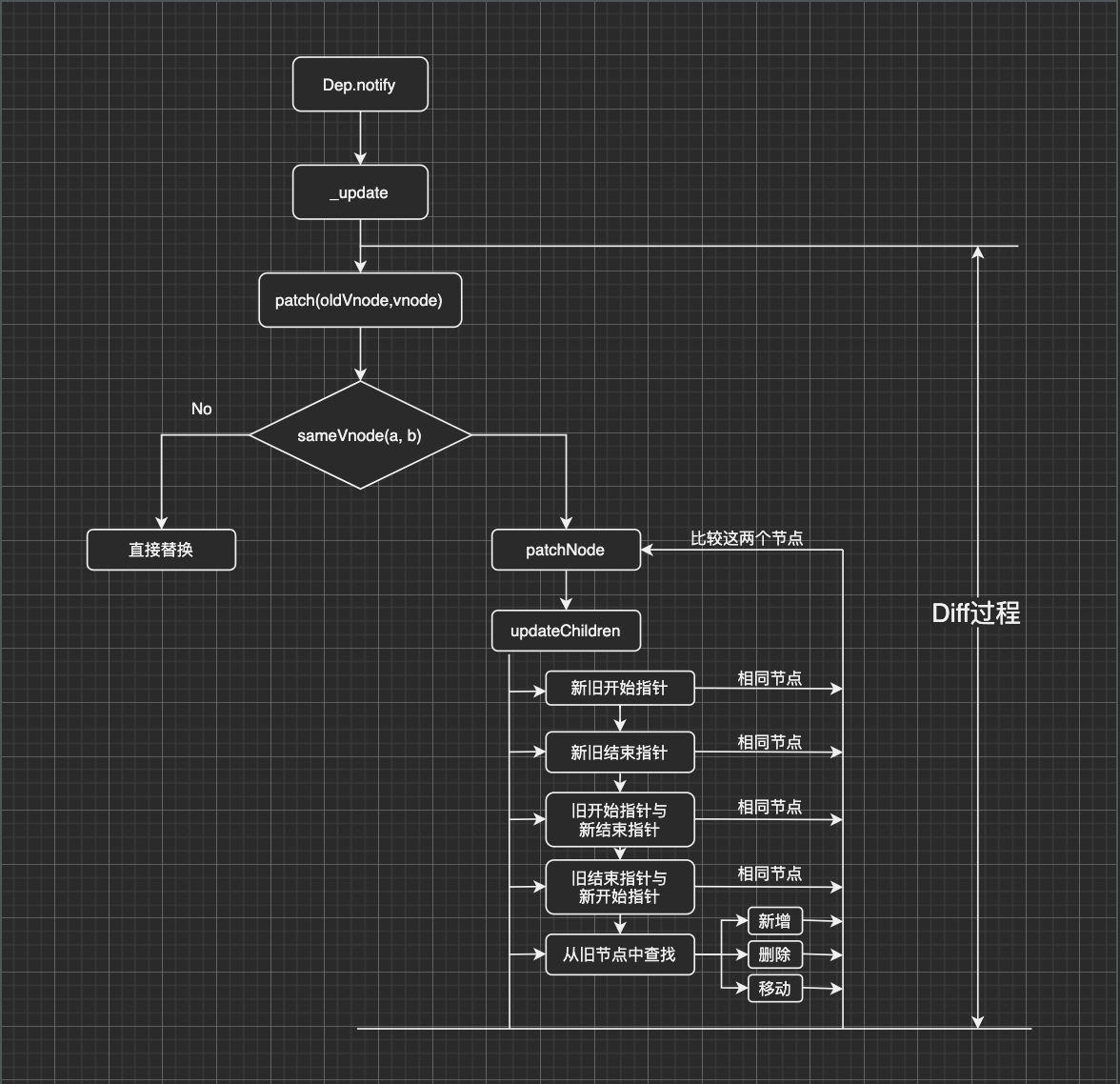介绍mvvm和mvc
MVVM 是 Model-View-ViewModel 的缩写
Model: 代表数据模型,也可以在Model中定义数据修改和操作的业务逻辑。我们可以把Model称为数据层,因为它仅仅关注数据本身,不关心任何行为.
View: 用户操作界面(UI组件)。当ViewModel对Model进行更新的时候,会通过数据绑定更新到View
ViewModel:业务逻辑层,View需要什么数据,ViewModel要提供这个数据;View有某些操作,ViewModel就要响应这些操作,所以可以说它是Model for View. ViewModel把Model和View关联起来
MVVM作为数据绑定的入口,整合Observer、Compile和Watcher三者,通过Observer来监听自己的model数据变化,通过Compile来解析编译模板指令,最终利用Watcher搭起Observer和Compile之间的通信桥梁,达到数据变化 -> 视图更新;视图交互变化(input) -> 数据model变更的双向绑定效果。
总结:MVVM模式简化了界面与业务的依赖,解决了数据频繁更新。MVVM 在使用当中,利用双向绑定技术,使得 Model 变化时,ViewModel 会自动更新,而 ViewModel 变化时,View 也会自动变化
实现一个简易mvvm
强烈推荐大佬的 gitHub地址(剖析Vue实现原理 - 如何实现双向绑定mvvm)[https://github.com/DMQ/mvvm]
最终效果
1
2
3
4
5
6
7
8
9
10
11
12
13
14
15
16
17
| <div id="app">
<h1>{{msg}}</h1>
<span>{{count}}</span>
<span>{{person}}</span>
</div>
<script src="vue.js"></script>
<script>
let vm = new Vue({
el: '#app',
data: {
msg: '模拟vue',
count: 22,
person: 'cpp'
}
})
vm.person = '陈大鹏'
</script>
|
vue.js
1
2
3
4
5
6
7
8
9
10
11
12
13
14
15
16
17
18
19
20
21
22
23
24
25
26
27
28
29
30
31
32
33
34
35
36
37
38
39
40
41
42
43
44
45
46
47
48
49
50
51
52
53
54
55
56
57
58
59
60
61
62
63
64
65
66
67
68
69
70
71
72
73
74
75
76
77
78
79
80
81
82
83
84
85
86
87
88
89
90
91
92
93
94
95
96
97
98
99
100
101
102
103
104
105
106
107
108
109
110
111
112
113
114
115
116
117
118
119
120
121
122
123
124
125
126
127
128
129
130
131
132
133
134
135
136
137
138
139
140
141
142
143
144
145
146
147
148
149
150
151
152
153
154
155
156
157
158
159
160
161
162
163
164
165
166
167
168
169
170
171
172
173
174
175
176
177
178
179
180
181
182
183
184
185
186
187
188
189
190
191
192
193
194
195
196
197
198
199
|
class Vue {
constructor(options = {}) {
this.$options = options || {}
this.$data = options.data || {}
this.$el = typeof options.el === 'string' ? document.querySelector(options.el) : options.el;
new Observer(this.$data)
new Compiler(this)
}
_proxyData(data) {
Object.keys(data).forEach(key => {
Object.defineProperty(this, key, {
get() {
return data[key]
},
set(val) {
if (val === data[key]) {
return
}
data[key] = val
}
})
})
}
}
class Observer {
constructor(data) {
this.walk(data)
}
walk(data) {
if (!data || typeof data !== 'object') {
return
}
Object.keys(data).forEach(key => {
this.defineReactive(data, key, data[key]);
this.walk(data[key])
})
}
defineReactive(obj, key, val) {
let dep = new Dep()
let that = this;
Object.defineProperty(obj, key, {
enumerable: true,
configurable: true,
get: function reactiveGetter() {
console.log('Dep.target 当前的wtacher 才能收集依赖')
Dep.target && dep.addSub(Dep.target)
return val
},
set: function reactiveSetter(newValue) {
if (val === newValue) {
return
}
that.walk(newValue);
dep.notify()
val = newValue
}
})
}
}
class Compiler {
constructor(vm) {
this.el = vm.$el;
this.vm = vm;
this.compile(this.el)
}
compile(el) {
let childNodes = el.childNodes
Array.from(childNodes).forEach((node) => {
if (this.isTextNode(node)) {
this.compileText(node)
} else if (this.isElementNode(node)) {
this.compileElement(node)
}
if (node && node.childNodes && node.childNodes.length) {
this.compile(node)
}
})
}
compileElement(node) {
Array.from(node.attributes).forEach((attr) => {
let attrName = attr.name
if (this.isDirective(attrName)) {
attrName = attrName.substr(2)
let key = attr.value
this.update(node, key, attrName)
}
})
}
update(node, key, attrName) {
this[attrName + 'Updater'] && this[attrName + 'Updater'](node, this.vm.$data[key], key)
}
textUpdater(node, value, key) {
node.textContent = value
new Watcher(this.vm.$data, key, (newValue) => {
node.textContent = newValue
})
}
modelUpdater (node, value, key) {
node.value = value;
new Watcher(this.vm.$data, key, (newValue) => {
node.value = newValue
})
node.addEventListener('input', () => {
this.vm.$data[key] = node.value
})
}
compileText(node) {
let reg = /\{\{(.+?)\}\}/;
let val = node.textContent;
if (reg.test(val)) {
let key = RegExp.$1.trim()
node.textContent = val.replace(reg, this.vm.$data[key]);
new Watcher(this.vm.$data, key, (val) => {
node.textContent = val
})
}
}
isDirective(attrName) {
return attrName.startsWith('v-')
}
isTextNode(node) {
return node.nodeType === 3
}
isElementNode(node) {
return node.nodeType === 1
}
}
class Dep {
constructor() {
this.subs = []
}
addSub(sub) {
console.log('addSub 开始收集依赖', sub)
this.subs.push(sub)
}
notify() {
this.subs.forEach((sub) => {
sub.update()
})
}
}
class Watcher {
constructor(vm, key, cb) {
this.vm = vm;
this.key = key;
this.cb = cb;
this.value = this.get()
}
get() {
Dep.target = this
var value = this.vm[this.key]
Dep.target = null
return value
}
update() {
var value = this.get()
var oldValue = this.value
if (value !== oldValue) {
this.value = value
this.cb(value)
}
}
}
|
参考



